Menus
- Fascination six-cylinder
- On the move: Benelli 750 Sei, Honda CBX 1000, Kawasaki Z 1300 – Part 2
- Benelli 750 Sci
- Honda CBX 1000
- Kawasaki Z 1300
- Six-cylinder history
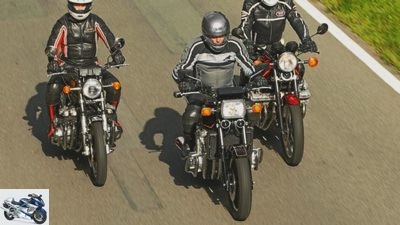
Bilski
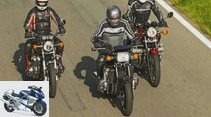
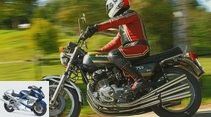
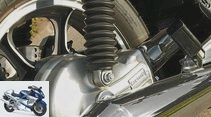
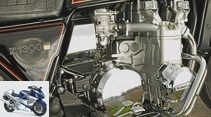
17th photos
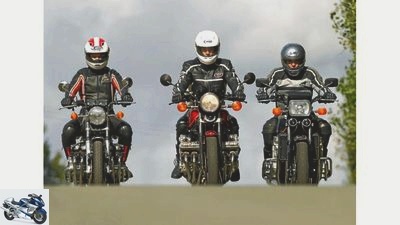
Bilski
1/17
Who is the widest in the whole country? The angle of spread of the driver’s legs provide information.
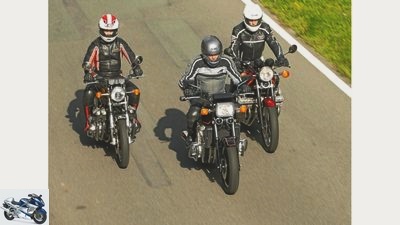
Bilski
2/17
With these three series motorcycles, Benelli, Honda and Kawasaki were the first to open up the fascination of the six-cylinder in motorcycle construction. The Benelli 750 Sei, the Honda CBX 1000 and the Kawasaki Z 1300.
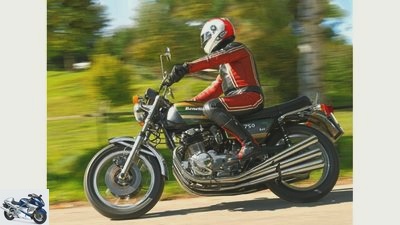
Bilski
3/17
Number one: The Benelli 750 Sei, which came on the market in 1972.
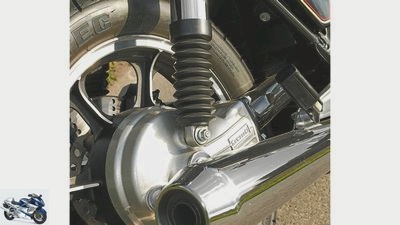
Bilski
4/17
A low-maintenance cardan drive underlines the touring suitability of the “King Kawasaki”. The load change reactions are clear.
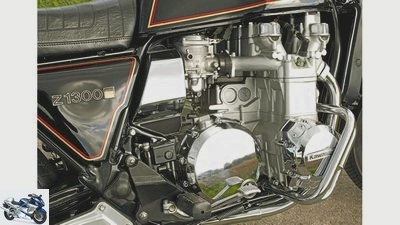
Bilski
5/17
Three modern double carburetors deliver the ignitable mixture. The second series received an injection system (Kawasaki Z 1300 DFI).
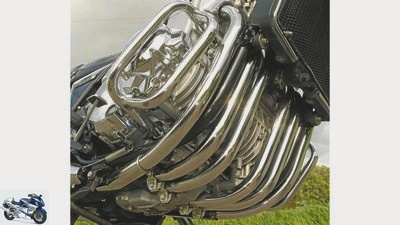
Bilski
6/17
The smooth-surfaced Kawasaki engine is hidden behind a water cooler, frame supports and six manifolds.
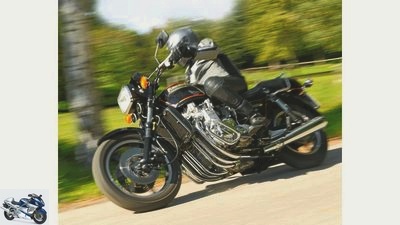
Bilski
7/17
Third in line: the Kawasaki Z 1300, which like the Honda had been available since 1978.
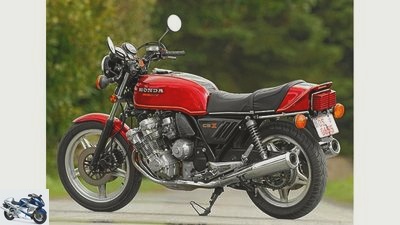
Bilski
8/17
The CBX looks well-proportioned: an unobstructed view of the engine, modern Comstar wheels, elegant tank-bench line.
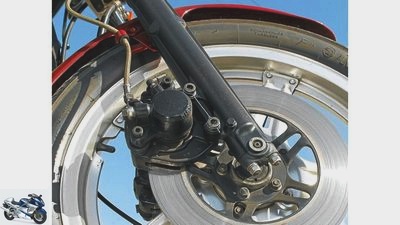
Bilski
9/17
The double disc showed only moderate braking power, the 35 fork was considered undersized at the time.
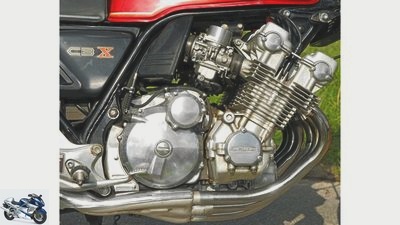
Bilski
10/17
Time-consuming: Synchronizing six carburettors is a fine craft.
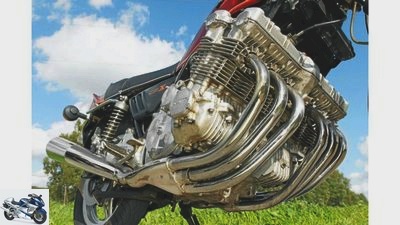
Bilski
11/17
The air-cooled CBX motor hangs completely freely in the backbone frame. The six elbows lead into two thick silencers.
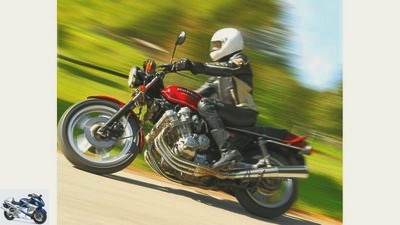
Bilski
12/17
The second in the field: the Honda CBX 1000, which was introduced in 1978.
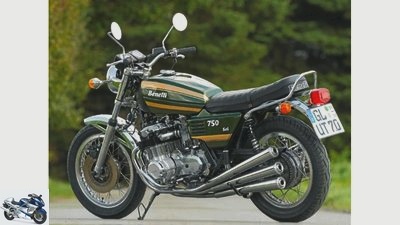
Bilski
13/17
Their slim shape makes the engine appear even more dominant. The exhaust pipes are reminiscent of the Honda racing machines.
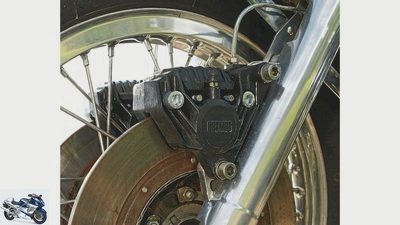
Bilski
14/17
The double disc brake with the two-piston fixed calipers from Brembo can handle the mass of the Benelli 750 Sei without complaint.

Bilski
15/17
The three Dell’Orto flat slide carburetors each supply two combustion chambers with a gasoline-air mixture via Y-shaped intake ports.
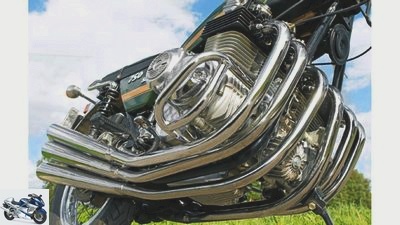
Bilski
16/17
Undoubtedly the most beautiful of all six-cylinder units with its intoxicating six-in-six exhaust system and the cooling fins.
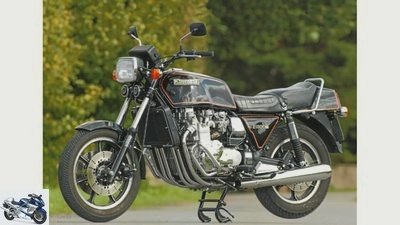
Bilski
17/17
The Z 1300 also packs a punch with its modern equipment: rectangular headlights, cast wheels, water cooling, cardan drive.
On the move: Benelli 750 Sei, Honda CBX 1000, Kawasaki Z 1300
Fascination six-cylinder
Content of
What could be more fascinating in motorcycle construction than a six-cylinder on two wheels? Three of these rare species! MOTORRAD CLASSIC seized the opportunity and drove the first series motorcycles, which already had a huge adrenaline rush with six-cylinder in-line engines.
The year is 2010. Two German motorcycle brands are drawing attention to themselves in the trade press with an impressive engine concept: So far there is only one study of the Horex VR6, a running engine and impressive technical data; The BMW K 1600 GT and GTL were able to admire visitors to the Intermot in Cologne in October. But they are not the first motorcycles to be powered by a six-cylinder unit.
Flashback 1979. In issue 18, MOTORRAD compares the Benelli 900 Sei, the Honda CBX and the Kawasaki Z 1300, three models that have one thing in common: six cylinders that provide propulsion. At the time, editor Hans-Peter Leicht philosophized: “All three machines live from their engines.” It’s the engines that inspire. Be it optically, through its sheer, ribbed megalomania, which opposes the airstream across the board, through its indescribable acoustics that go through the bone, or through its turbine-like power delivery from all engine speeds. Six-cylinder motorcycles turn the hairs on the neck into wire bristles.
When the businessman Alessandro de Tomaso took over the Benelli brand in 1971, he gave the order to build a motorcycle of superlatives. In October of the following year, the company from Pesaro presented the 750 Sei. The world’s first series-produced six-cylinder motorcycle – a sensation. It was beyond imagination.
A displacement of 747 cm³ was distributed among six cylinders with cooling ribs in a row arrangement, which appeared as wide as the installation dimensions of a refrigerator. While three Dell’Orto VHB 24 flat slide carburettors were hidden under the tank on the inlet side, the six-in-six system cheekily stretched its staggered chrome megaphones towards the audience on the outlet side. The Sei drew attention to itself like a magnet with iron filings. But Benelli kept postponing the start of sales.
Bilski
Their slim shape makes the engine appear even more dominant. The exhaust pipes are reminiscent of the Honda racing machines.
It wasn’t until the spring of 1975 that interested parties in Germany could buy the 750 from dealers. In the meantime, due to inflation in Italy, their price had risen from a forecast 9,000 to almost 11,000 marks, and the other major manufacturers had not stood still during this period either. Although they did not have a six-cylinder in their range, they now have a number of interesting high-displacement motorcycles at far more affordable conditions. Think, for example, of the BMW R 90 S, the Ducati 750 SS, Moto Guzzi 850 GT, Norton Commando 850 or the Kawasaki Z 900.
Around 3500 copies of the 750 Benelli were made in five years of production. Essentially, it was only optically modeled and replaced by the 900 Sei in 1978. Only 500 machines found their way from Pesaro across the Alps to Germany. Honda took its time responding to Benelli’s 750 cc. It was not until 1978 that the company from the Far East presented the flagship of its model range with the CBX 1000 Super Sport. Honda engineer Soichiro Irimajiri, who designed the successful six-cylinder GP racer in the 1960s, was responsible for this “super sports car”.
He constructed a powerful air-cooled in-line six-cylinder with a displacement of 1046 cm³, which hung in a bridge frame, causing a sensation as a load-bearing element. He put 105 hp on the roll. The MOTORRAD readers spontaneously voted the CBX “Motorcycle of the Year 1978”. Already in the first sales year 1979, almost 1,600 machines found a buyer in this country. Between 1978 and 1985, Honda sold around 6,000 machines in Germany. The CBX not only appeared as the flagship of the largest motorcycle manufacturer, but also marked a change in its previous business policy. “What we want to offer in the future are sporty motorcycles that arouse more emotions than in the past,” said Honda President Kiyoshi Kawashima at the time.
The engineers had designed the CBX as a sports machine, which, with a top speed of 220 km / h, was one of the fastest street motorcycles of its time. At the same time, they tried to save weight in order to at least partially compensate for the weight of the 106 kg engine.
Bilski
The CBX looks well-proportioned: an unobstructed view of the engine, modern Comstar wheels, elegant tank-bench line.
For the frame they managed with only 14.3 kg of steel, despite the high demands on the chassis of such a powerful motorcycle. The camshafts and front wheel axles were hollow, and at two kilograms the seat was even a light weight. Honda used aluminum where possible and even turned off bolts. On the other hand, the factory did not skimp on the equipment: spring struts adjustable in rebound and compression, an H4 headlight and modern Comstar wheels instead of the wire-spoke wheels, which are considered obsolete, completed them. The CBX rolled on tubeless tires that were specially developed by Dunlop and Yokohama, which was just as much a premiere as the O-ring chain, which was installed for the first time, which was intended to reduce wear on the secondary drive.
When Japan’s smallest motorcycle manufacturer presented the “King Kawasaki”, the largest of all six-cylinders at IFMA in 1978, the colossus surpassed everything before – including the Honda CBX presented in the spring of the same year. The water-cooled in-line engine of the Z 1300 had an impressive 1286 cm³ displacement and developed 120 hp. For the first time a motorcycle engine achieved a torque of more than 100 Nm. The monster weighed 318 kg with a full tank and achieved a top speed of 217 km / h.
Kawasaki had designed the Z 1300 as a touring machine, and if the term Supertourer had existed back then, it would have been made for them. The almost luxurious equipment would have looked good on many more modern motorcycles: a low-maintenance cardan drive, fuel and temperature display as well as the automatic turn signal reset via an odometer in the speedometer. A red light in the instruments served as an electronic oil level control, the air-assisted telescopic fork ensured comfort, and from the second model series onwards, the rear shock absorbers were also cushioned with air assistance. Like the CBX, the Kawasaki rolls on tubeless tires.
From 1984 it received the petrol injection familiar from the Z 1100 GP. This should help to keep their high fuel consumption in check, one of the few serious criticisms in the MOTORRAD test at the time. The power of the Z 1300 DFI increased to 130 hp in the unthrottled version. When it was voted “Motorcycle of the Year 1978”, it came second behind the CBX. However, it competed less with the Honda than with the Yamaha XS 1100.
Despite their obvious qualities, only around 1200 copies found a buyer in Germany. Allegedly, Kawasaki would have had to sell 8,000 units per year in order to recoup the development and production costs.
On the move: Benelli 750 Sei, Honda CBX 1000, Kawasaki Z 1300 – Part 2
Bilski
Who is the widest in the whole country? The angle of spread of the driver’s legs provide information.
Back to the present, on-site visit in Osnabruck. The early autumn sun reflects its warming rays in the chrome of a Benelli 750 Sei, a Honda CBX 1000 and a Kawasaki Z 1300. They were the first three motorcycles to be given two more cylinders ex works than the – just established – large-volume in-line four-cylinder models. Now they are waiting to explore Lower Saxony’s country roads. Today, technical data, top speed and maximum power are less important than the experience of this type of engine, which unfortunately is rarely installed in two-wheelers.
The 750 Sei made available to us was registered in October 1975, shortly after Benelli launched the model on the German market. It stands there as if it came straight from production. The previous owner had it extensively restored and the engine overhauled. The speedometer shows a virgin 600 kilometers. Only its green paintwork with the gold stripes on the tank does not match the original design. It is a bit reminiscent of the Z 900 from 1974. However, this appearance suits the Benelli well.
The machine exudes the charm of the early 1970s, when wire-spoke wheels were still “in” and Kickstarter were seen as a complement to the electric starter. She wanted to belong to the really big ones, on par with models like the Honda CB 750 and the already mentioned Z 900. If you stand in front of her, she looks rather small and petite. Apart from its large engine, it is a narrow motorcycle with a low seat height.
Sitting on it is correspondingly easy. The driver crouches slightly bent forward, knees resting on the elongated tank. Its edge is pressed into the inside of the thighs, the transition to the bench is not quite as harmonious as with the CBX. The left foot can easily find its place on the notch, the right foot has to hang around under the alternator housing, which protrudes from the side of the engine like a flanged can, to the footrest.
Almost in awe, I open the fuel tap, operate the choke lever attached to the left side of the carburetor battery and press the tiny start button on the cube-shaped plastic fittings. The Italian comes to life spontaneously. At first it spurts restlessly from its six megaphones like the radial engine of an old double-decker. After a few minutes it has calmed down and runs smoothly so that the choke can be withdrawn.
Bilski
The Z 1300 also packs a punch with its modern equipment: rectangular headlights, cast wheels, water cooling, cardan drive.
The first gear engages exactly after a short distance, then the Benelli sets off. Loud, cheeky, snotty, this Ferrari on two wheels smashes its joie de vivre from the chrome-plated six-in-six organ into the blue autumn sky when accelerating. It’s like a hurricane swelling that seems to come from all sides. Despite its weight of 255 kg, it looks handy at first. It can be swung effortlessly through curves at low speed. It only reacts somewhat stubbornly to steering commands when driving faster. Your chassis is Italian firm, comfort is different. The angular handlebar fittings appear archaic. The hands of the briquette-shaped Veglia instruments fidget in time with the firing order of the six and allow the correct speed and speed to be guessed more than read off.
And yes, driving the Sei is fun! You can also go fast with it. But it is not the speed that causes this tingling sensation in the neck, nor are there any vibrations – after all, an in-line six-cylinder is known for its smoothness, as all inertial forces and moments are balanced. It’s their honest, direct expressiveness, the beguiling sound from the exhaust pipes that rolls in from behind when you accelerate and gives your back goose bumps – unique, not good.
The engine of the Honda CBX is completely different. It already visually dominates its appearance, placing its broad, ribbed cylinder bank across the airstream. No frame tube and no radiator blocked the wonderful view of this mighty and at the same time aesthetic six-cylinder block. The shiny chrome manifolds swing in two elegant groups of three past the oil filter under the engine block and open into two long, voluminous silencers.
Its dimensions are smaller than the sight suggests: the crankcase measures just 61 cm. We didn’t want to believe it and measured it again. That’s less than the Benelli and Kawasaki. The air-cooled cylinders rise above this over a width of 57 cm. How much one can be fooled.
As usual with other Honda models, the driver sits very comfortably on the CBX. The hands find handles and levers in blind trust. The tank nestles inconspicuously between the thighs. Even though it covers almost the entire cylinder bank.
The starter turns the crankshaft with a chirp, the battery seems a little overwhelmed. Then the Honda patters off. Their sound is somewhat reminiscent of the Mercedes W113 Pagode, the double-cam six-cylinder from the 1960s: when idling, the timing chains in the engine rattle audibly, and the 24 valves tickle lightly. A courageous twist on the throttle lets the mechanical noises fade into the background and elicits a serious roar from the six-in-two system, which turns into a real hiss at higher speeds.
Bilski
With these three series motorcycles, Benelli, Honda and Kawasaki were the first to open up the fascination of the six-cylinder in motorcycle construction. The Benelli 750 Sei, the Honda CBX 1000 and the Kawasaki Z 1300.
Once in motion, the power of the straight six is present in every situation. At 50 km / h, the Honda glides carefree in top gear, its engine purring gently like a kitten. Suddenly tearing open the six throttle valves turns him into a big cat that is pushing forward vehemently. The CBX accelerates out of the range of revs without resisting. Then it hums again evenly, as if nothing had happened.
The weaknesses of Honda criticized in MOTORRAD 19/1979 can also be understood at present. Your brakes, which were called lax at the time, are no better today. The double disc at the front is only spongy, and the pressure point is also quite squishy at the back.
The chassis received clear criticism. The unstable frame, in connection with the fork tubes that were too thin and the plastic swing arm bearings in the first series, was no match for the ready-to-drive 290 kg motorcycle and the powerful engine. The machine sways gently on uneven roads, and the too soft undercarriage lurches in undulating curves like a sailing yacht in rough seas and only slowly calms down.
Such problems were alien to the Kawasaki Z 1300. The seating comfort is just as relaxed as on the CBX. A quick press of the start button is all it takes for the engine to start operating with an unspectacular whisper. Its sight is also unspectacular. The water-cooled engine has a smooth surface and looks more modern than the other two, it does not attract much attention. In addition, the large water cooler hides the view of the cylinder bank. Fully encapsulated, it filters mechanical noises, its soft sound could also come from a six-cylinder BMW.
As soon as the "Z" rolls, it seems to have dropped its mass. It can be directed with little effort. Tight bends, however, quickly show how quickly metal can scratch asphalt, and it is advisable to carefully feel the limits. The Kawasaki is perfect for covering long distances quickly and comfortably. Like a turbine, it develops its power when accelerating, and the transmission can be shifted smoothly. As a rule, it is sufficient to select the highest gear early on and simply leave it in. The elasticity of their engine is enormous to this day.
Bilski
Benelli 750 Sei, Honda CBX 1000 and Kawasaki Z 1300
Your brakes can be controlled better than those of the Honda and also show their effect more quickly. But when the two front brake calipers grab, more than six hundred pounds of mass plunge deep into the fork legs, like a camel that wants to kneel down at a watering place after three weeks of crossing the Sahara to quench its thirst. Maybe our test machine just lacks some air in the fork. When the load has come to a standstill, the driver has the choice between placing it on the side stand or balancing it on the main stand. In MOTORRAD issue 3/1979 testers compared jacking up the Z 1300 with a test of courage that not only requires strength but also practice. And the idea of having to straighten a folded Z 1300 inspires respect.
The Kawasaki embodies the 1980s in our trio. It offered modern technology and a lot of luxury, but never flaunted it. Still, it didn’t sell too well. What all three machines have in common is that they are powered by a six-cylinder in-line engine and that they come from the motorcycle era in which motorcycling developed into a purely recreational pleasure. However, their characters are completely different.
The slim Benelli is sporty and aggressive, the huge Kawasaki as a comfortable touring machine with a wide range of equipment. The Honda is somewhere in between: designed as a "Super sport"-Motorcycle, she is more of a sports tourer. One thing unites the three again: They have now exceeded 30 years and are therefore considered to be classic cars. But that doesn’t mean that they are a long way off.
Benelli 750 Sci
Bilski
The Benelli 750 Sei
| engine | design type | Air-cooled six-cylinder four-stroke in-line engine, one overhead camshaft, two valves each operated by rocker arms |
| drilling | 56 mm | Hub | 50.6 mm |
| Displacement | 747 cm3 | compression | 9.8: 1 |
| power | 63 hp at 9000 rpm | Torque | 57 Nm at 4800 rpm |
| Mixture preparation | Three Dell’Orto slide carburetors, Ø 26 mm | Electrical system | starter | Kick and electric starters |
| battery | 12 V / 20 Ah | ignition | Interrupter-controlled battery / coil ignition |
| alternator | Alternating current | Power transmission | coupling | Multi-disc oil bath |
| transmission | Five-speed claw shift | Secondary drive | Chain |
| landing gear | |
| Frame type | Double loop frame made of tubular steel | Front wheel guide | Telescopic fork |
| Rear wheel guide | Two-arm steel swing arm, two spring struts | Front / rear suspension travel | 120/85 mm |
| bikes | Wire spoke wheels | Front tires | 3.50 H 18 |
| Rear tire | 4.00 H 18 | Front brake | Double disc Ø 230 mm |
| rear brake | Drum brake Ø 200 mm | mass and weight |
Weight | 255 kg |
| Tank capacity | 22 liters | Seat height | 740 mm |
| Performance | |
| Top speed | 200 km / h |
| price | 10,989 marks (1975) |
| Manufacturer | Benelli Q. J. srl Pesaro, Italy |
Honda CBX 1000
Bilski
The Honda CBX 1000
| engine | design type | Air-cooled six-cylinder four-stroke in-line engine, two overhead camshafts, four valves each operated by bucket tappets |
| drilling | 64.5 mm | Hub | 53.4 mm |
| Displacement | 1046 cm3 | compression | 9.3: 1 |
| power | 106 hp at 9100 rpm | Torque | – |
| Mixture preparation | Six Keihin constant pressure carburettors, Ø 28 mm | Electric investment | starter | Electric starter |
| battery | 12 V / 14 Ah | ignition | Contactless |
| alternator | Three-phase current | Power transmission | coupling | Multi-disc oil bath |
| transmission | Five-speed claw shift | Secondary drive | Chain |
| landing gear | |
| Frame type | Backbone frame made of tubular steel | Front wheel guide | Telescopic fork |
| Rear wheel guide | Two-arm steel swing arm, two spring struts | Front / rear suspension travel | 160/100 mm |
| bikes | Comstar wheels | Front tires | 3.50 V 19 tubeless |
| Rear tire | 4.25 V 18 tubeless | Front brake | Double disc Ø 280 mm |
| rear brake | Disc Ø 292 mm | mass and weight | Weight | 274 kg |
| Tank capacity | 24 liters | Seat height | 780 mm |
| Performance | |
| Top speed | 219 km / h |
| price | 11,262 marks (1978) |
| Manufacturer | Honda Motor Co., Ltd. Tokyo, Japan |
Kawasaki Z 1300
Bilski
The Kawasaki Z 1300
| engine | design type | Water-cooled six-cylinder four-stroke in-line engine, two overhead camshafts, each two valves operated by bucket tappets |
| drilling | 62 mm | Hub | 71 mm |
| Displacement | 1286 cm3 | compression | 9.9: 1 |
| power | 120 hp at 8000 rpm | Torque | – |
| Mixture preparation | Three Mikuni double carburettors, Ø 32 mm | Electrical system | starter | Electric starter |
| battery | 12 V / 20 Ah | ignition | Contactless |
| alternator | Three-phase current | Power transmission | coupling | Multi-disc oil bath |
| transmission | Five-speed claw shift | Secondary drive | Cardan |
| landing gear | |
| Frame type | Double loop frame made of tubular steel | Front wheel guide | Telescopic fork |
| Rear wheel guide | Two-arm steel swing arm, two spring struts | Front / rear suspension travel | 200/105 mm |
| bikes | Cast wheels | Front tires | 4.10 V 18 tubeless |
| Rear tire | 5.10 V 17 tubeless | Front brake | Double disc Ø 260 mm |
| rear brake | Disc Ø 250 mm | mass and weight | Weight | 322 kg |
| Tank capacity | 27 liters | Seat height | 800 mm |
| Performance | |
| Top speed | 213 km / h |
| price | 12,228 marks (1979) |
| Manufacturer | Kawasaki Heavy Industries, Tokyo, Japan |
Bilski
The classic dealer Wolfgang Fuchs.
Wolfgang Fuchs from Osnabruck made these three wonderful six-cylinders available to us. His shop is on the outskirts of Osnabruck, in the immediate vicinity of the Osnabruck-Sud motorway junction. He trades in classic cars and motorcycles.
It was only five years ago that Fuchs decided to devote himself to his passion and give up his previous work in credit management. Together with his technician Hans, he set up the company. Hans used to race on bevel Ducatis and traveled all over the world as a motorcycle mechanic. His specialty is building Moto Guzzi Cafe Racers, which he still puts on in small numbers today. Motorrad Fuchs usually offers around 50 classic motorcycles on its homepage. Interested parties can find youngtimers as well as pre- and post-war motorcycles, Englishmen, Italian sports machines and occasionally historical racing machines and unusual motorcycles, such as a British Greeves.
The special thing is that Fuchs has not specialized in one type or brand, but always tries to offer an interesting mix, with a focus on youngtimers. In the future, he wants to integrate trading in historical racing machines more into his business. As he himself says, his company has now developed into an almost worldwide trading company for classic motorcycles. And Fuchs claims to be able to procure almost any motorcycle they want for their customers.
Fuchs Motorrad, Meller Strasse 283, 49084 Osnabruck
Tel. 0541-404390, www.motorrad-fuchs.com
Six-cylinder history




12th photos
Pictures: On the move: Benelli 750 Sei, Honda CBX 1000, Kawasaki Z 1300
To home page
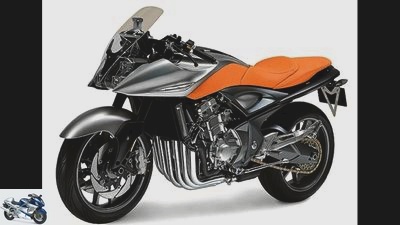
archive
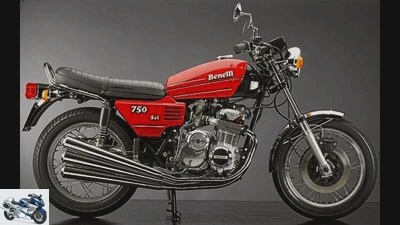
archive
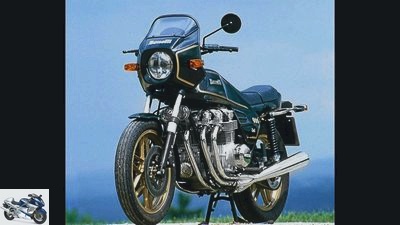
archive
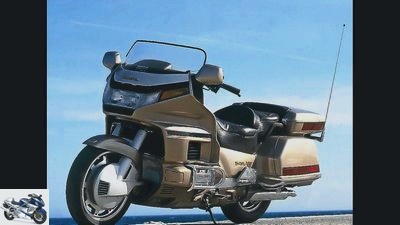
archive
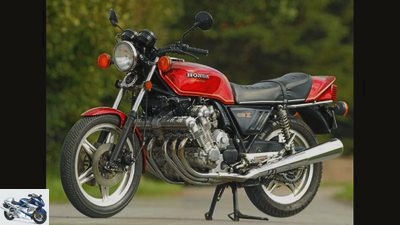
archive
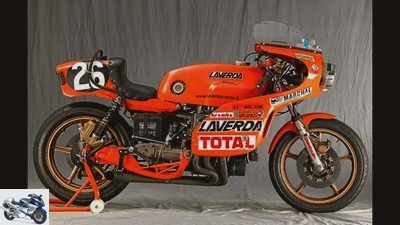
archive
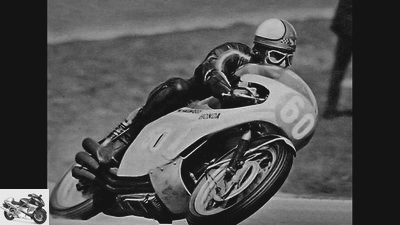
archive
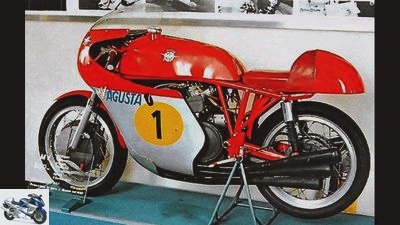
archive
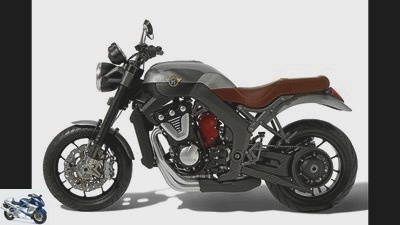
archive
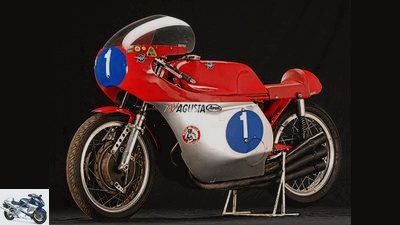
archive
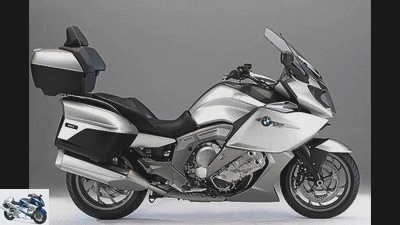
archive
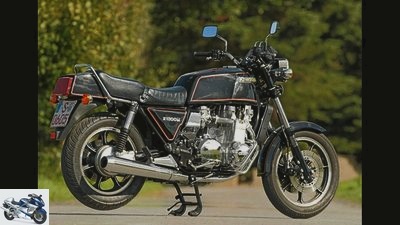
archive
Related articles
-
On the move with the Honda CB 900 F Bol d‘Or, Honda CBX, Kawasaki Z 1000 ST and Kawasaki Z 1300
Arturo Rivas 45 pictures Arturo Rivas 1/45 Six against four for first: Honda CBX and Honda CB 900 Bol d’Or. Arturo Rivas 2/45 Honda CBX. Arturo Rivas 3/45 …
-
fact Concept comparison Honda CBR 1100 XX Kawasaki ZX-12 R Suzuki GSX-R 1000 Suzuki GSX 1400 Yamaha FZS 1000 Fazer Yamaha FJR 1300 Six bombs The six …
-
On the move with Honda CB 1100 F and Kawasaki GPZ 1100 B2
www.factstudio.de 29 pictures factstudio.de 1/29 picture gallery: Honda CB 1100 F and Kawasaki GPZ 1100 B2 on the move. factstudio.de 2/29 Honda CB 1100 F and …
-
On the move with the Honda GL 1000 Gold Wing
Jahn 11 pictures Jahn 1/11 In view of the enlightening driving impressions with the Honda Gold Wing from 1977, many old prejudices have to be straightened out ….
-
Gargolov comparison test big bikes: Honda CBR 1100 XX Super Blackbird, Kawasaki Ninja ZX-12R, Suzuki GSX 1300 R Hayabusa, Yamaha FJR 1300 A Two fast, Two …
-
Comparison test: Honda CB 1000 R, Yamaha FZ1, Triumph Speed Triple, Kawasaki Z 1000
Comparison test: Honda CB 1000 R, Yamaha FZ1, Triumph Speed Triple, Kawasaki Z 1000 Large naked bikes in comparison Contents of …
-
BMW F 800 GT, Kawasaki Z 1000 SX and Honda VFR 800 F in the test
fact 44 pictures fact 1/44 fact 2/44 fact 3/44 fact 4/44 fact 5/44 Praise to the diversity: The three test candidates all want the same thing, but are looking for it …
-
On the move with a Kawasaki Z 1000 and Zephyr 1100
www.bilski-fotografie.de 36 pictures www.bilski-fotografie.de 1/36 Genetically not related, but they belong to the same family: Kawasaki Z 1000 and …
-
On the move: Honda VF 1000 R, Kawasaki GP Z 900 R, Suzuki GSX-R 1100
Jahn On the move: Honda VF 1000 R, Kawasaki GP Z 900 R, Suzuki GSX-R 1100 Technical revolution Contents of They drove us crazy – and …
-
On the move with the Honda XL 600 V Transalp
Volker Rost 26 pictures Volker Rost 1/26 Honda XL 600 V Transalp. Volker Rost 2/26 Honda had not had any luck with two-cylinder enduros until then. People…